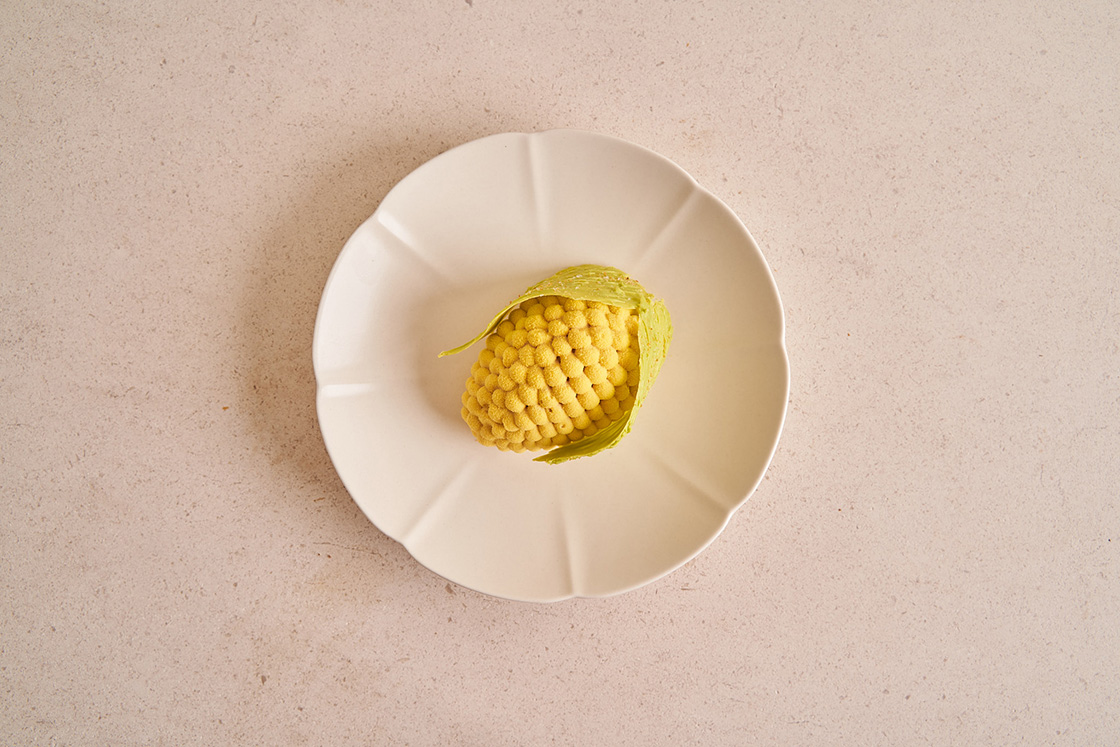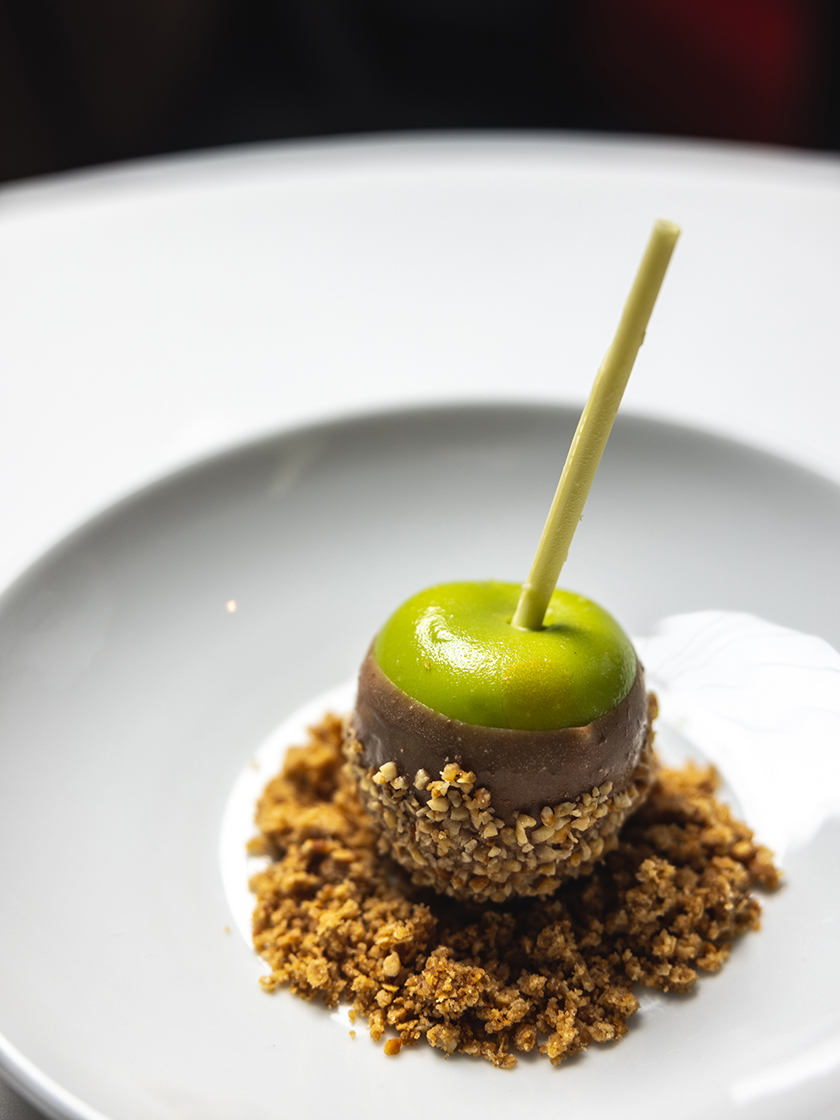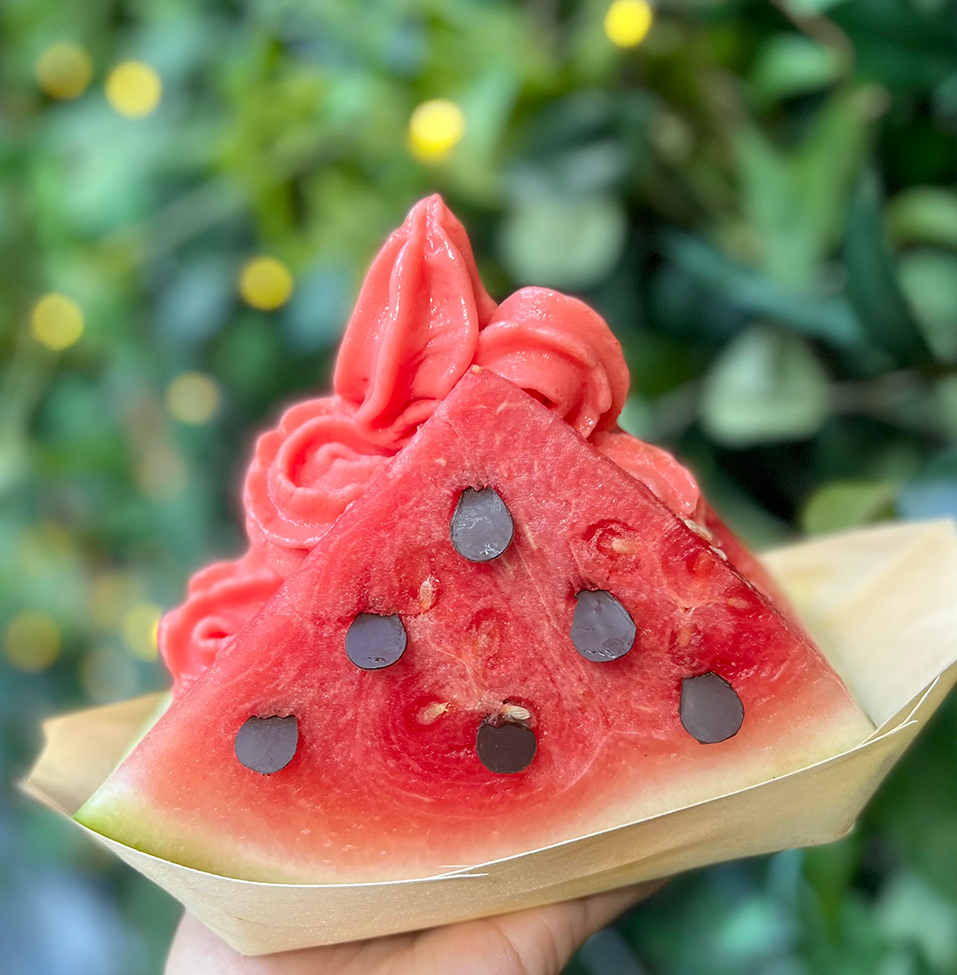Do you ever feel guilty eating a whole pint of ice cream? Or how about wishing you ate more fruits instead of another pack of cookies? If so, then we’ve got the perfect thing for you. From watermelon shaped soft serve to carrot cake in the shape of (yes, you guessed it) a carrot, MICHELIN Guide talents have shown time and time again that innovation is just around the corner. Below, we take a deep dive on some of the most innovative desserts that MICHELIN Guide restaurants have to offer. And while they may not meet the healthy quota, you’ll at least look the part while eating them.
Jungsik, Yoonjung Oh, Executive Pastry Chef
"Carrot"
Two Star Jungsik is no stranger to the spotlight. Home to an original “New Korean” cuisine, this Harrison Street hotspot is responsible for some of the cities most delicious desserts. First it was the Baby Banana (banana cake shaped like a literal small banana) from previous pastry chef Eunji Lee (who is now at Lysée, but we’ll get to that later). Now, it’s a carrot cake in the form of a carrot from executive pastry chef Yoonjung Oh (previously of Two Star Aquavit). Essentially a carrot cake in the form of a carrot, this dish dares guests to harvest their own dessert.
Pastry chef Yoonjung Oh’s journey with dessert started at a young age. “I’ve always loved cake ever since I was young,” says Oh. “Whether it was actually eating cake or even just watching videos about it online, I always saw it as something that I at least wanted to have as a hobby.” When her parents suggested that she should come to New York with her brother, she knew that it was the perfect opportunity to kickstart her career in desserts. Following that love of cake and pastry that she had, Oh enrolled in the Culinary Institute of America (CIA).
It was at the CIA that Oh realized that like food, pastry can provide not only sustenance, but also a sense of enjoyment. “Pretty much all major life achievements and milestones are celebrated with loved ones and often include sharing a cake,” Oh adds. “Its significance resonates with people from all walks of life.” But Oh’s passion in creating pastries under a fine dining setting didn’t come until her first “Plated Dessert” class at the CIA. “It seemed like it was an area of pastry where I could really push myself both technically and creatively.” From there, Oh went on to work for Two Star Aquavit and now Jungsik.
While at Aquavit, Oh learned to infuse savory flavors onto the plate and upholding the highest standards. At Jungsik, Oh hopes share Korean culture through Korean ingredients (black tea from Hadong, South Korea; dried persimmon or Gotgam, artemisia or ssuk, Korean green plum or Maesil, Omija, and Yuja) and serving dishes with Korean cultural significance. Another example is the Hodugwaja; a walnut cake snack that is synonymous with apple cider donuts in America during the fall season.
On top of that, Oh wants to create a fun dessert program that to make guests smile. “The pastries we make here are all supposed to invoke a type of childish happiness,” says Oh. That philosophy of fun is what led to the creation of the carrot dessert. “Just because we are a fine dining restaurant, it doesn't mean that our guests don't want to have fun.” And for guests, the fun starts the second they see the dessert. First, each component (carrot cake, cream cheese mousse, and pecan praline encased within a white chocolate shell) is prepped into a mold and frozen. Next, the frozen “carrots” are dipped into an orange colored chocolate, with white chocolate used to draw in white little lines for detail and realism. Finally, chocolate is sprayed on top to mimic soil dusting, and the dessert is then served in a a planter filled with edible dirt (it’s carrot cake crumble, so don’t worry about worms), the “carrot” is a that is then painted to resemble a real carrot. Top that off with black tea ice cream (which is inspired by Oh’s love for enjoying carrot cake with milk tea), Oh’s creation is equal parts interactive, unique, and delicious.
“My hope is that when people dig into our garden to harvest their carrot, it’ll make them feel like a kid again - even if it’s only for a brief moment,” Oh adds. “It truly is a unique and fun experience, and seeing the look on guests face when they’re reaching into the garden to carefully harvest their carrot is always satisfying for me.”

Lysee, Eunji Lee, Founder/Pastry Chef
"Corn"
Remember Eunji Lee from before? Transitioning from Two Star Jungsik (and the Baby Banana), Lysée is Lee’s newest passion project. Tucked right inside the Flatiron District, this pastry boutique features a dessert gallery with pastries (no touching!) on display, along with a menu of French, Korean, and New York City influences. With desserts like the Corn (a corn mousse cake in the shape of a corn) and Lysée cake (signature mousse cake), Lysée is the perfect marriage of art and dessert.
Derived from the word Musée (French for museum) and chef’s last name, Lee, the focus of Lysée has and always will be on pastries. “The pastry here is the hero,” Lee says. “You can go upstairs to the second floor for the display, or you can go downstairs and enjoy the actual pastries. It’s not only good to see, but it’s also good to eat.”
Now you may be wondering, what separates the desserts at Lysée from fine dining restaurants? Besides the gallery, the answer is planning. At a fine dining restaurant, desserts come at the end of a course. This requires planning with executive chefs and making sure the flavors of the dessert flow together with the menu. This means the dessert doesn’t need to be particularly rich or heavy in flavor. Compared to that, the pastries at Lysée can be more fun and experimental.
The Corn mousse cake, is one of those experiments. Inspired from Lee’s love of corn, this dessert was created when the pastry chef realized that while there were a lot of corn flavored desserts, there weren’t any that was using actual corn. “I just wanted others to taste what I really liked,” explains Lee.
But creating the dish requires several steps. First, sponge cake batter is mixed with corn flour (for corn flavor), and meringue. After a liberal sprinkle of corn powder, the batter heads to the oven. Once out, the cake is divided into rain drop shapes. After that is the corn sable (which goes at the base of the dish), and a corn mousse (which covers the dish). Once dried, Lee hand pipes corn kernels onto each serving. “In the beginning, each kernel took me about 90 seconds to make,” Lee tells me. “Now, after more than a year of practice, it takes maybe thirty or forty seconds.” Add to that a yellow colored white chocolate sauce that’s sprayed over the dessert, along with corn leaves (made from green-tinted white chocolate), and the Corn from Lysée was born.

Lambs Club, Jack Logue, Executive Chef/Partner
"Apple"
Originally the county’s first professional theatrical club, one of Midtown’s oldest institutions (1905 to be exact) is back with MICHELIN Star talents chef Jack Logue (Two Star Daniel and The Clocktower) and Chris Miller (Two Star Atera). Featuring a menu filled with elevated classic American dishes, the goal of Lamb’s Club is to bridge the past together with the present. “We want to lean into the nostalgia of what it was like to either be a kid growing up and eating in the city, or a first timer in New York City and what they might experience,” says chef Jack Logue. The Caramel Apple, serves as one of those bridges.
“The idea behind the Apple was to create something that was both visually fun and creative and at the same time a representative of iconic New York City (aka the Big Apple),” explains Logue. “We wanted to play on my childhood. Growing up in New York City and going apple picking or eating candied apples is such a strong memory for me. On top of that, apples are also my favorite fruit!”
Unlike real apples though, these apples aren’t picked from a tree. First, vanilla and mascarpone mousse along with diced caramelized apples are stuffed inside semi sphere molds. After freezing, the two half spheres are connected to create a full sphere, which is then frozen again. These full spheres are then dipped in a mixture of liquified coco butter and tempered white chocolate that has been dyed with a natural green coloring made from a pea and spinach extract. Once the coco shells have settled, gold powder made from luster dust is hand painted onto the dessert, mimicking natural blemishes that real apples have. Then, the shells are dipped halfway in caramel and chopped nuts. Last but not least, a white chocolate stick is applied, and a water heavy simple syrup is sprayed on the dessert - giving the illusion of a freshly washed apple.
“When the guest goes to eat it, the dish evolves into something very different and more enjoyable,” Logue adds. “It’s such a fun and delicious dish.”

Dominique Ansel Bakery, Dominique Ansel, Owner
"Watermelon"
One of New York City’s premier pastry chefs, Dominique Ansel is responsible for inventing the Cronut, a croissant-donut hybrid that took the world by storm. With his bakery, the France native is doing it again. Originally opened in November 2011, Ansel’s bakery went from a small neighborhood bakery to a global phenomenon, with an online shop offering pastries to 48 U.S. states and four stores spread throughout New York, Las Vegas, and Hong Kong.
For Dominique Ansel, pastries is a science. “Everything has to be measured, precise, and exact,” Ansel tells me. “It’s a combination of art and science, and once you learn the foundations, the creativity and the possibilities for what you can create are endless. That has stuck with me ever since.”
That creativity, combined with an emphasis on highlighting the best in-season ingredients and a desire for people to eat more fruit is what led to the creation of the What-A-Melon soft serve - a dessert consisting of water melon slices with soft serve (made from watermelon juice and a hint of lime) tucked in the middle. “We wanted to serve watermelon in a new and totally different way while using all of the fruit,” Ansel adds. “It’s all about fresh fruit in every bite. From the wedge of the watermelon it’s served in, to the watermelon soft serve swirled inside that’s made from all the fresh watermelon juice.”
To do this, ripe pink watermelons are sliced into wedges. The juice (along with a dash of fresh lime for an extra bit of tang) is then used to make the watermelon soft serve. To finish things off, hundreds of tiny dark chocolate “seeds” are hand-cut and placed onto each wedge. “People were so excited about it when we initially started serving it,” says Ansel. “I remember seeing our lines go all the way down the block. People even wore watermelon earrings and t-shirts! Now, we bring it back every summer and it's a lot of fun.”
And while the What-a-Melon Soft Serve is only available during the summer, guests can still visit (or order online) for an endless array of pie, tarts, and of course, freshly made Cronuts.

Discover now: MICHELIN Guide Inspectors’ Favorite Desserts in Colorado
Joomak Banjum, Kelly Nam, Executive Pastry Chef/Partner
"Green Pea"
Executive pastry chef of One Star Joomak Banjum, Kelly Nam is no stranger to the spotlight. Winner of the MICHELIN Guide New York 2022 Pastry Chef of the year, the pastry chef's goal is to create desserts with some nostalgia and a dash of mind-boggling. “I love giving guests something to talk about,” says Nam. “You're always too full, out of things to talk about, or just low in energy by the time dessert hits. I hope to give our guests a bit of 'going out with a bang' so to speak. Something that jolts them up or get fired up about talking again.”
“Every spring, I get excited to put a pea dessert on the menu,” explains Nam. “It changes every year, but for this year, I wanted it to look like a pea as well.” Also known as the dessert salad, the first step for creating this dish involves making a basil tuile base that’s spread, dried, and then rewarmed to be shaped into a pea pod. This shell is then filled with dill Chantilly and pea cremeux. After that, Genmai chiffon cake is used to prop up the “pea” Sorrel ice cream. With the pea assembled, garnishes such as cashew crumble, affilla cress, chick pea shoots, and pea or fava bean flowers are added.




















